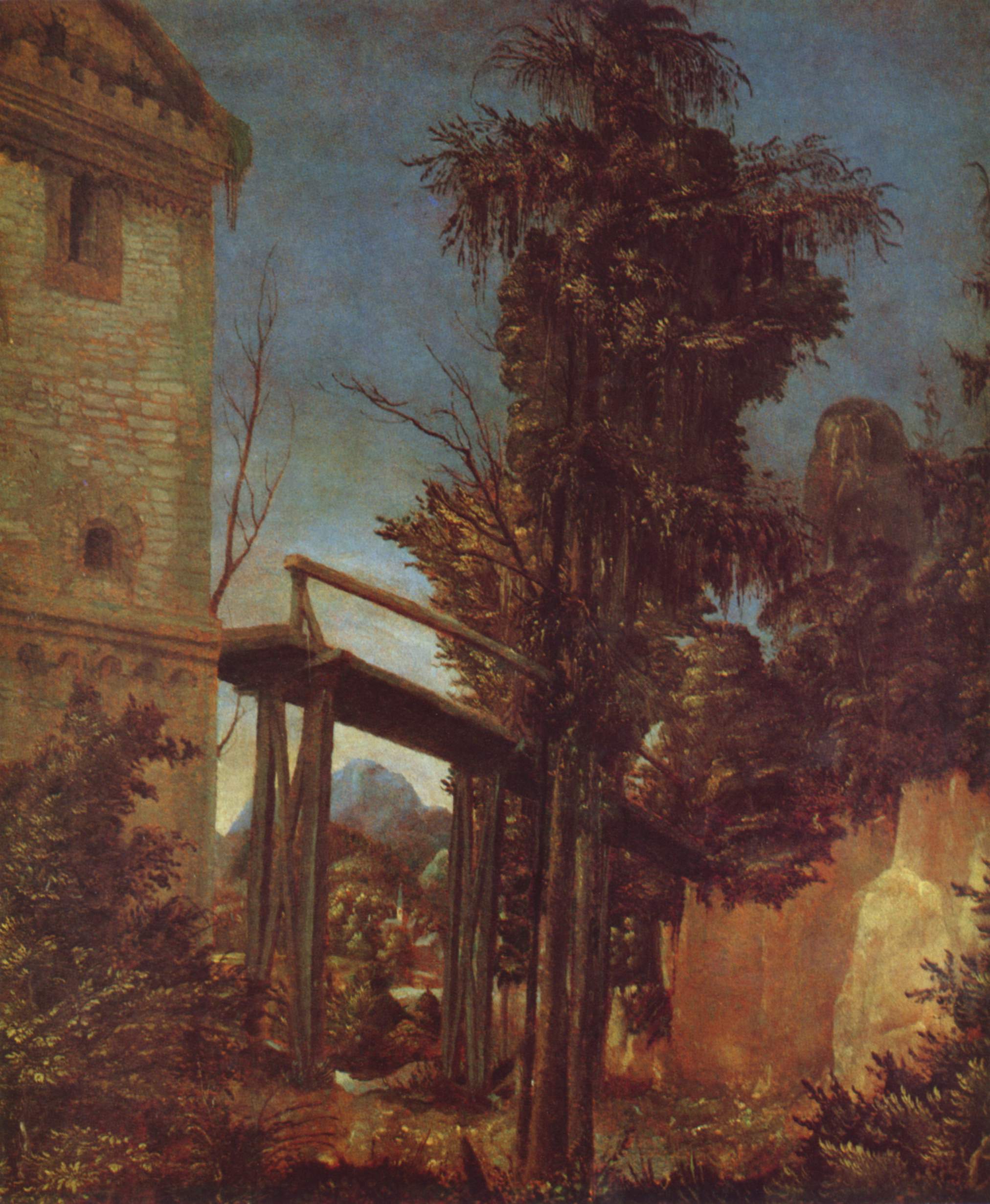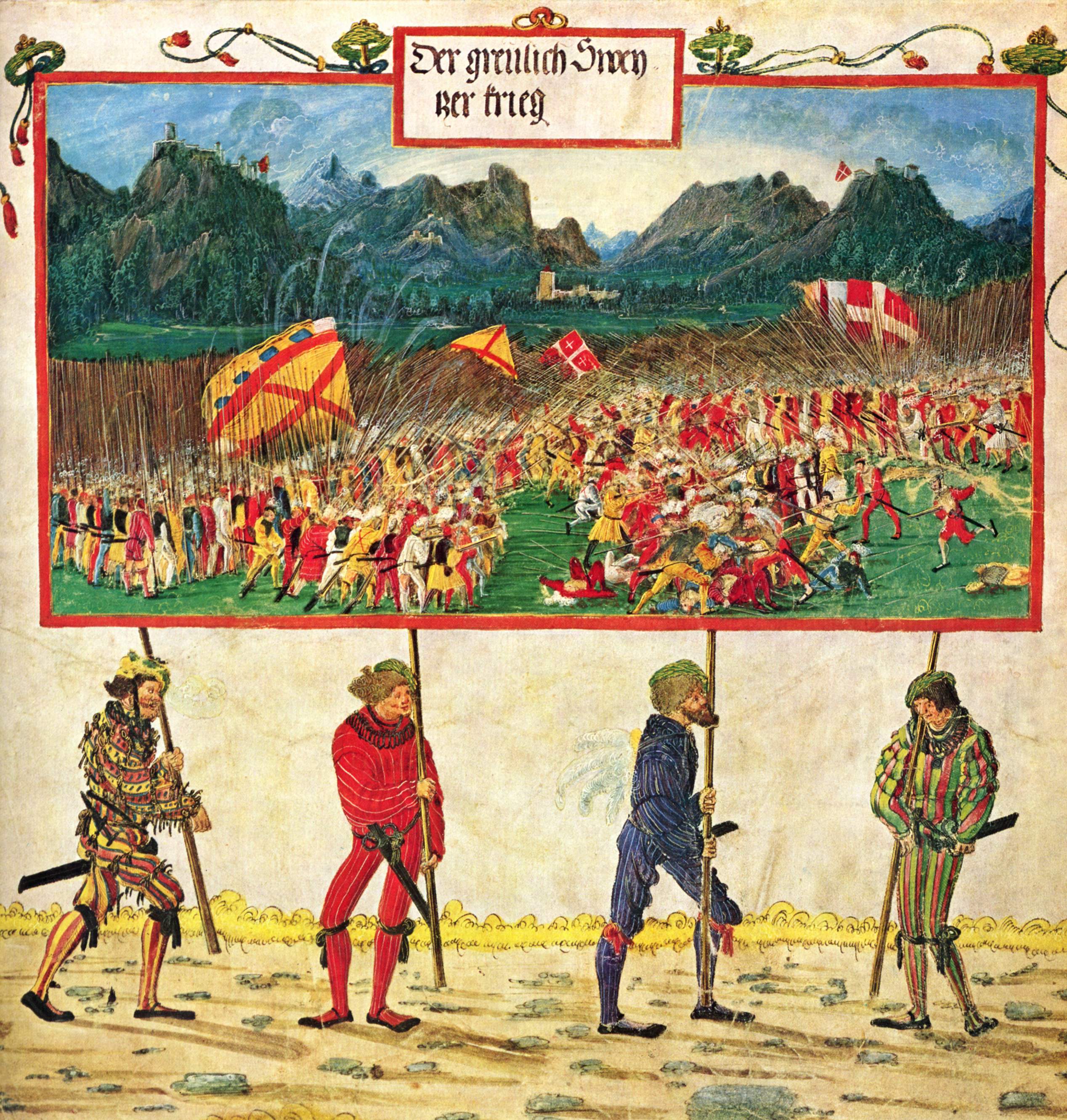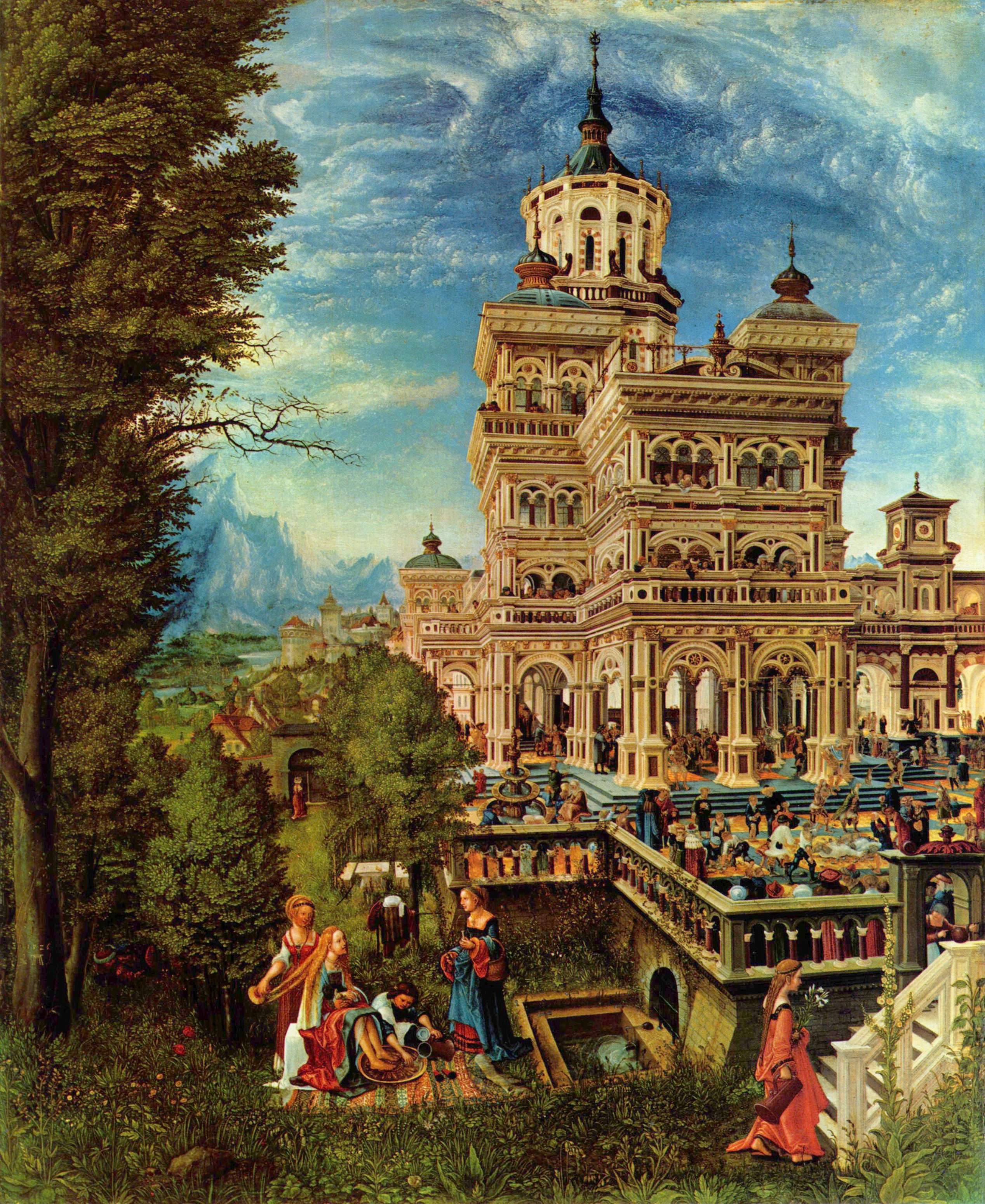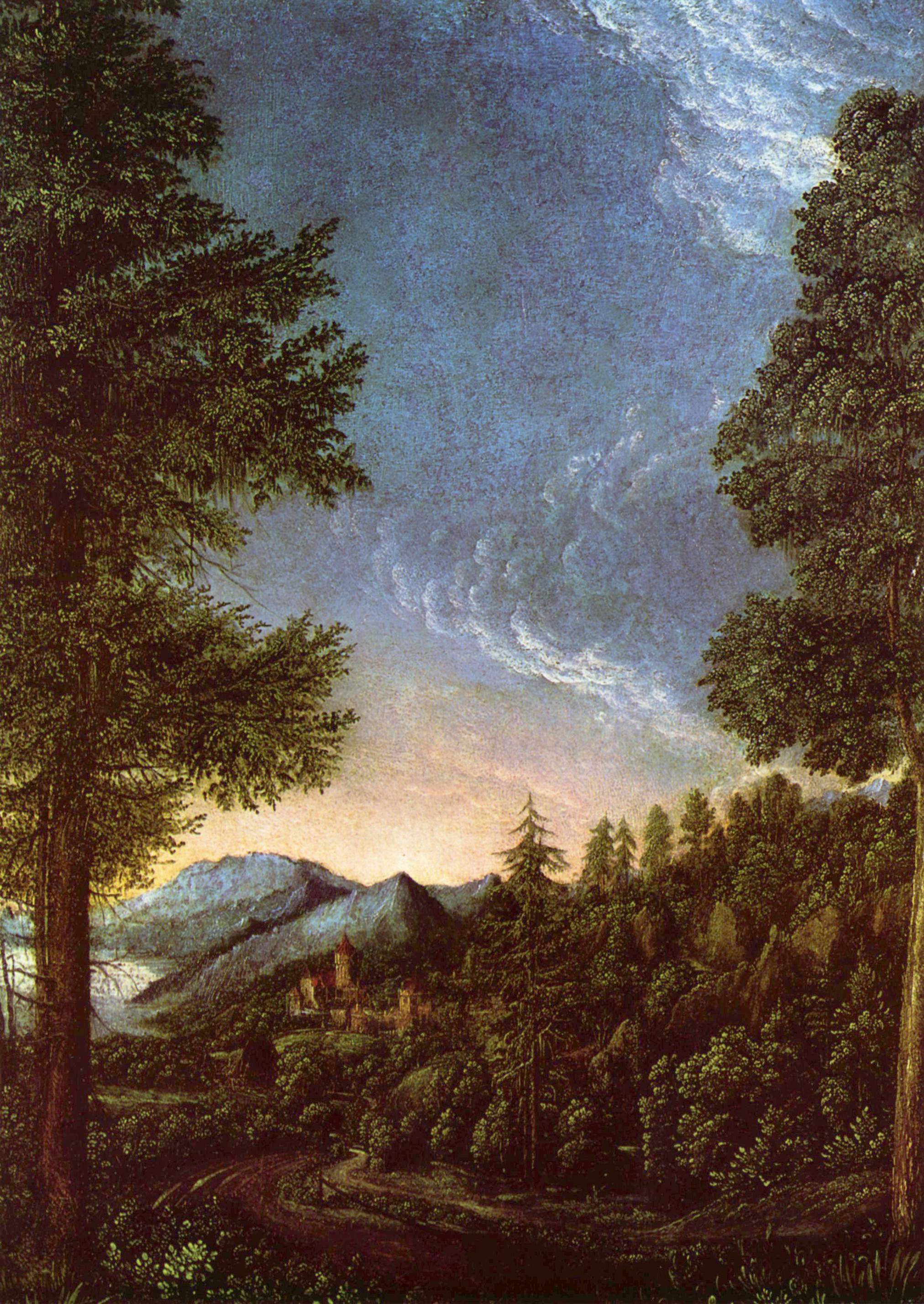- Albrecht Altdorfer
Albrecht Altdorfer (c. 1480 near
Regensburg –12 February 1538 inRegensburg ) was a German painter,printmaker andarchitect of theRenaissance era, the leader of theDanube School in southernGermany , and a near-contemporary ofAlbrecht Dürer . He is best known as a significant pioneer of landscape in art.Painting
He most often painted religious scenes, but is mainly famous as the first frequent painter of pure landscape, and also compositions dominated by their landscape. Taking and developing the landscape style of
Lucas Cranach the Elder , he shows the hilly landscape of the Danube valley with thick forests of drooping and crumbling firs and larches hung with moss, and often dramatic colouring from a rising or setting sun. His "Landscape with footbridge" (National Gallery, London ) of 1518-20 is claimed to be the first pure landscape in oil. [http://commons.wikimedia.org/wiki/
] He also made many fine finished drawings, mostly landscapes, in pen andwatercolour . His best religious scenes are intense, sometimes verging on the expressionistic, and often depict moments of intimacy between Christ and his mother, or others. His most famous religious artwork is the "The Legend of St. Sebastian and the Passion of Christ" that decorated the altar in the St. Florian monastery inLinz , Austria. He often distorts perspective to subtle effect. His donor figures are often painted completely out of scale with the main scene, as in paintings of the previous centuries. He also painted some portraits; overall his painted oeuvre was not large.Paintings in Munich
His rather atypical "Battle of Issus" (or of "Alexander") of 1529 was commissioned by
William IV, Duke of Bavaria as one of a suite by various artists. It is his most famous, and certainly one of his best works. He renounced the office of Major of Regensburg to accept the commission. Few of his other paintings resemble this apocalyptic scene of two huge armies dominated by an extravagant landscape seen from a very high viewpoint, which looks south over the whole Mediterranean from modern Turkey to include the island ofCyprus and the mouths of theNile and theRed Sea (behind the isthmus to the left) on the other side. However his style here is a development of that of a number of miniatures of battle-scenes he had done much earlier forMaximilian I, Holy Roman Emperor in hisilluminated manuscript "Triumphal Procession" in 1512-14. [http://commons.wikimedia.org/wiki/
]The "Battle" is now in the
Alte Pinakothek , which has the best collection of Altdorfer's paintings, including also his small "St George and the Dragon",(1510) in oil onparchment , where the saint and the dragon are small figures almost submerged in the dense forest that towers over them. A "Susanna and the Elders" (1526) set outside an Italianate skyscraper of a palace shows his interest in architecture. [http://commons.wikimedia.org/wiki/
] Another small oil on parchment, "Danube Landscape with Castle Wörth" (c 1520) is one of the earliest accurate topographical paintings of a particular building in its setting, of a type that was to become a cliché in later centuries. [http://commons.wikimedia.org/wiki/
]Printmaking
He was a significant
printmaker with numerousengraving s and about ninety-threewoodcut s. These included some for the "Triumphs of Maximilian", where he followed the overall style presumably set byHans Burgkmair , although he was able to escape somewhat from this in his depictions of the more disorderly baggage-train, still coming through a mountain landscape. However most of his best prints areetching s, many of landscapes; in these he was able most easily to use his drawing style. [http://www.metmuseum.org/toah/hd/intg/ho_1993.1097.htm] He was one of the most successful early etchers, and was unusual for his generation of German printmakers in doing no book illustrations. He often combined etching and engraving techniques in a single plate, and produced about 122 intaglio prints altogether.Public life
He was a member of the ruling town council in Regensburg for many years, as well as the city
architect and worked on improving the city walls. He presumably participated in the Council's decision to expel the city's Jewish community in 1519 , as well as making two famous etchings of thesynagogue just before it was destroyed after the expulsion, to be replaced with a church, which Altdorfer designed, at least in part. [http://www.jg-regensburg.de/graphics/altdorfer2.jpg] [http://www.uwm.edu/~corre/buxdorf/regensburg2.jpg] Later he became a Protestant, and helped to steer Regensburg toLutheranism .Albrecht's brother,
Erhard Altdorfer , was also a painter and printmaker in woodcut and engraving, and a pupil ofLucas Cranach the Elder .ee also
*
Early Renaissance painting References
*Alte Pinakotek, Munich; (Summary Catalogue -various authors),1986, Edition Lipp,ISBN 3874907015
*CS Wood, Albrecht Altdorfer and the Origins of Landscape, 1993, Reaktion Books, London, ISBN 0948462469External links
* [http://collections.tepapa.govt.nz/search.aspx?advanced=colProProductionMakers%3a%22Altdorfer%2c+Albrecht%22+colCollectionGroup%3aCH Works by Albrecht Altdofer at the Museum of New Zealand Te Papa Tongarewa]
* [http://www.zeno.org/Kunstwerke/A/Altdorfer,+Albrecht Works by Altdorfer at Zeno.org]
* [http://www.all-art.org/history230-10-2.html Albrecht Altdorfer in the "History of Art"]
* [http://www.art-wallpaper.com/Wallpapers/Altdorfer+Albrecht Albrecht Altdorfer Wallpapers]
* [http://www.artcyclopedia.com/artists/altdorfer_albrecht.html Page at artcyclopedia.com]
* [http://www.ibiblio.org/wm/paint/auth/altdorfer/ Page at ibiblio.org]
* [http://gallery.euroweb.hu/html/a/altdorfe/ Page at gallery.euroweb.hu]Persondata
NAME=Altdorfer, Albrecht
ALTERNATIVE NAMES=
SHORT DESCRIPTION=German renaissance painter
DATE OF BIRTH=about 1480
PLACE OF BIRTH=Regensburg
DATE OF DEATH=death date|1538|2|12|df=y
PLACE OF DEATH=Regensburg
Wikimedia Foundation. 2010.
